

The 8 Fastest Cruising Catamarans (With Speedchart)
As an Amazon Associate, we earn from qualifying purchases. We may also earn commissions if you purchase products from other retailers after clicking on a link from our site.
Cruising catamarans are some of the most comfortable boats to roam the water, making them fantastic for both long-term voyages and short-term vacations. Still, cruising catamarans can be great racing boats, but just how fast can they go?
Some of the fastest cruising catamarans include the Gunboat 68 (35 knots), Outremer 45 (25 knots), ORC50 (25 knots), FastCat 435 (20 knots), TS 42 (35 knots), and Lagoon 440 (20 knots). Yet, there are many more cats that can reach 35 knots safely.
If you are interested in knowing about the fastest cruising catamarans, I have you covered. I will be discussing some of the most popular, fastest cruising catamarans and the features that make them so excellent for sailors in need of speed. You will learn more about each catamaran’s speed and amenities, and I will let you know a trick or two to maximize your speed under sail.
How Fast Are Cruising Catamarans?
On average, cruising catamarans can reach top speeds of 15 knots , around 17.3 mph (27.84 kph). However, some exceptional, racing-designed cruising catamarans can reach up to 30+ knots in the right wind conditions.
When you want to better understand catamaran hull characteristics, I suggest the book Catamarans a Complete Guide (amazon link) by the president of Aeroyacht catamarans and that you check out my article Why catamarans capsize .
Factors That Impact Speed
Weight & size.
When you consider a catamaran’s speed, you will need to keep in mind the boat’s weight and narrowness. A vessel that can travel at 15 knots will still move slower if the boat is heavy or has a wide, extensive hull. When increasing the total weight of the boat, the boat “sits” lower in the water, thus increasing water drag and reducing speed.
Why trimarans are faster than catamarans!
Now that we know how weight impacts sailing characteristics, it follows that; if you are planning on racing your catamaran, you should remove as much luggage or extra gear as possible. Eliminating as much weight as possible will help you travel at your cat’s maximum speed .
Narrow Hulls
The hydrodynamics of the ship will heavily affect your speed. Narrower boats can chop through the water with less effort, making slender ships with pointed hulls far faster than wide vessels. So if you are looking for the fastest one available, you should look for a slender hull.
Slim hulls vs. space is a common tradeoff for catamarans optimized for family sailing .
Wind will also affect your ship’s speed, so do not expect your cruising catamaran to reach the maximum speed without heavy wind. Generally, cruising catamarans have two large sails (at least) to power them through the water, and some are so efficient that they can travel even faster than the wind.
Although a strong wind is needed to energize the sails and move the boat, too much wind will instead make the sails less efficient, and maximum speed is most often attained at lower wind speeds but with flat water.
Light Weight Materials
Faster cruising catamarans are often made from carbon fiber materials and fiberglass to keep the weight down. If you are looking for the quickest catamaran that you can find, you should note the materials that the ship is made out of and try to get one that is primarily made from carbon, glass, and resin materials.
While you are looking for the perfect catamaran for you, you should keep in mind what you NEED and what is NICE with your ship. Usually, this decision is between size and speed, but some of these excellent vessels have both.
Lightweight materials are usually costly; for example, a carbon fiber mast will probably cost you +$20 000, depending on the cat’s size.
I have written a buyer’s guide that explains the concept of NEED vs. NICE , which will make choosing the right boat faster and more accurate.
Gunboat 68 (+35Kts)
Gunboat 68 is a cruising catamaran designed to reach the highest speeds possible. Made by Gunboat, the ship uses Grand-Prix racing boats’ designs to develop the speediest cruising catamaran on the market.
Gunboat 68 is made entirely from carbon composites, which keeps the ship lightweight and fast. Gunboat 68 is the perfect catamaran for anyone who wants to reach the highest speeds possible while maintaining control of the vessel and not bouncing around too much.
Gunboat 68 has comfortable, spacious living quarters, though it also has a spacious deck with luxurious seating. Indeed, this cat has it all, making it one of the best cruising catamarans for racers and casual sailors. The design maximizes all of the living spaces and uses lightweight materials to add elegance and luxury to a speedy racing catamaran.
Gunboat 68 is one of the fastest cruising cats out there, with its maximum speed at more than 30 knots . Gunboat 68 can achieve these fast speeds, thanks to its lightweight construction and narrow hull design.
Still, Gunboat can customize your ship’s plan to accommodate your needs. Whether you are looking for a faster, more lightweight boat with a more extensive sail or a more comfortable cruiser, Gunboat 68 is an excellent option for you.
Specifications
- Maximum Speed: 35 knots
- Length: 68 ft (20.75 m)
- Beam: 29.9 ft (9.1 m)
- Draft: 3.9 ft (1.2 m) board up and 9.84 ft (3.8 m) board down
- Displacement: 23.7 tonnes
TS 42 (ORC 42)
The TS, or Tres Simple , cruising catamarans, designed by Marsaudon Composites, are some of the fastest cruising catamarans in the world.
Marsaudon developed the ship’s plans using racing boats’ streamlined designs and combined them with a cruising catamaran’s comfortable living spaces. The TS 42 has an inverted hull which helps it glide on the water swiftly without requiring much fuel, but it also has a spacious below-deck area with plenty of luxuries.
TS cruising catamarans are often considered the fastest cruisers on the market, with their speed comfortably reaching upwards of 35 knots in the right wind conditions. Generally, TS catamarans can sail at 20 knots, even with moderate wind. They are the perfect catamaran for racers and high-speed travelers, and yet they still have the amenities of a pleasant live-in vessel.
The TS 42 has a large galley and comfortable cabins, making it a cozy home or vacation vessel. With multiple bathrooms, large windows, and open lounge spaces, these catamarans are superbly comfortable to live in.
The deck and cabin space are divided by a large, openable window, which adds extra light and ventilation to the living areas. It also has plenty of on-deck space, which is rare in such a small vessel with an inverted hull.
If you think I’m using too many confusing nautical terms, you’ll find all the answers on my Catamaran parts explained page .
- Length: 42.8 ft (13 m)
- Beam: 24.3 ft (7.4 m)
- Draft: 4.9 ft (1.5 m) with boards up and 7.5 ft (2.3 m) with boards down
- Displacement: 5.8 tonnes
Outremer 45
Based in France, Outremer (pronounced uutremeer 😉 ) designed their Outremer 45 to be a long-lasting cruising catamaran that sails smoothly at high speeds. The Outremer 45 can reach about 15 knots, but the most comfortable sailing speed is 10 knots. However, it can travel up to 25 knots in the right wind conditions, making it a quick ship with all of a perfect cruising catamaran’s luxuries.
It is made for durability from carbon, vinyl ester, and divinycell so that it can last many years without repairs. The Outremer 45 has a narrow hull, and it is designed to be as thin as possible to maximize speed and fuel efficiency. Outremer 45 still has comfortable living quarters with large windows and lounge spaces within the boat. Indeed, it sacrifices no comfort for speed.
In this article, I talk a lot about catamaran characteristics, both interior and exterior, if that’s something you want to better understand, then I recommend an article where I write about trade-offs in design choices .
The Outremer 45 was initially designed to be a boat that would last 50 or more years, and it excels in its durability. It has an open, uniquely expansive side deck and plenty of on-deck conveniences that make sailing a breeze in the ORC50.
With supreme safety features such as tall railings, slip-free grips on deck, and enclosed lounge spaces, it is one of the safest catamarans available (is safety your top concern? I wrote a list of the safest catamarans on the market).
- Maximum Speed: 25 knots
- Length: 48 ft (14.6 m)
- Beam: 23.3 ft (7.1 m)
- Draft: 3.3 ft (1 m) with boards up and 6.7 ft (2.04 m) with boards down
- Displacement: 8.2 to 11.1 tonnes
Marsaudon Composites ORC50
Marsaudon Composites designed the ORC50, or Ocean Rider Catamaran 50, with both speed and comfort in mind. The ORC50 can be used for cruising, but it is also a great racing boat that has been awarded honors from many races worldwide.
Marsaudon borrowed designs from racing skippers to plan the ORC50, bringing together a cruiser’s comfort with the speed of an award-winning racing boat.
This cruising catamaran is lightweight, which allows it to gain speed at a fast rate, but still has comfortable living quarters inside the boat. It has a rotating carbon mast, which helps to eliminate turbulence over the mainsail and therefore increasing sail efficiency and speed!
With strong winds, the ORC50 can reach up to 23 knots , making it extremely fast for a cruising catamaran. The ORC50 can easily reach speeds much faster than the wind speed, which is a unique quality of this fast, yet comfortable catamaran.
The ORC50 is an excellent long-term living ship with its many organizational compartments, expansive galley, and well-ventilated sleeping cabin. It also has plenty of couches and seating areas built into the boat, and its intuitive design adds plenty of comfort to the cruising catamaran without weighing down the ship.
- Length: 50 ft (15.23 m)
- Beam: 27 ft (8.2 m)
- Draft: 5.6 ft (1.7 m) with boards up and 8.9 ft (2.7 m) with boards down
- Displacement: 13 tonnes
FastCat 435
African Cat’s catamarans, including the FastCat 435, are designed for speed and racing. This ship is mainly composed of epoxy, fiberglass, and carbon components, making it very lightweight to ensure that it travels as swiftly as possible.
The FastCat 435 may be as light as possible, but it is durable enough to last for many years in the most extreme conditions.
The FastCat 435 has comfortable living quarters and well-designed comfort spaces so that you can get the most out of your trips. The FastCat also has a green hybrid design, and it uses primarily electric power, which can help you prolong your sailing and use less fuel.
I find solar-powered/electric cats pretty exciting, so much so that I wrote an entire article called The Best Solar-Powered Catamarans on the subject.
The FastCat is an excellent option for anyone who wants a smaller cat with a comfortable design and incredible speed. FastCat’s electric power is also a unique, favorable feature for anyone who wants to use less fuel.
- Maximum Speed: 20 knots
- Length: 42.7 ft (13 m)
- Beam: 24.4 ft (7.4 m)
- Draft: 3.9 ft (1.2 m) with boards up
- Displacement: 2.4 tonnes
The Lagoon 440 cruising catamaran, like the FastCat, has an electric powering version, which cuts down on fossil fuel usage and ensures that your ship will keep moving. The Lagoon 440 is also among the easiest catamarans to maneuver, thanks to its electric drivetrain and automatic engines.
The speed of the Lagoon 440 usually maxes out at 10 knots with low winds, but with higher winds, it can quickly gain speeds up to 20 knots (some argue even higher, but I’m doubtful). The Lagoon 440 is an excellent cruiser and comfortable catamaran, but it is not an all-out racing cat.
Lagoon is a well-known brand, but there are some caveats, and are Lagoons still making good catamarans?
Below the deck, the living spaces in the Lagoon 440 are magnificent. The ceilings are high, allowing the tallest of passengers to stand in the cabin. The many storage compartments and furnishings have a modern, elegant design. The interior is one large primary cabin with a few private spaces below the deck.
- Length: 44.6 ft (13.6 m)
- Beam: 25.3 ft (7.7 m)
- Draft: 4.3 ft (1.3 m)
- Displacement: 10.5 tonnes
Fountaine Pajot Astréa 42
Fountaine Pajot designs some of the most luxurious yet speedy cruising catamarans available in the world. They are renowned for their safe, durable designs that make sailing a comfortable, relaxing experience. And on a personal note, i think the name sounds beautiful!
Their cruising catamarans use an inverted hull design that has become a signature mark of Fountaine Pajot vessels. This hull type allows the water to pass beneath the ship quickly, which increases the speed and fuel efficiency of the cat.
The Astréa 42’s primary benefit is its spacious, comfortable living quarters and large, open deck spaces. The ship’s interior spaces have large windows, large lounging areas, and plenty of storage compartments.
The cabin’s ventilation is also excellent, which reduces the classic musty smells of sea living. You can also get two different models of this catamaran, either in a one-cabin option or a two-cabin option, making it an excellent vessel for larger or smaller families.
The Astréa is ideal for long-term sea living and family vacations (it is not as fast as some more racing-oriented cats). Although the Astréa is not the speediest cat available, with its speed maxing out at about 10+ knots, even in favorable wind conditions, its luxurious atmosphere and comfortable cabin spaces make up for its relatively slow speed.
Don’t get me wrong, despite its lower speed compared to the boats on this list, the Astréa 42 can still get you places quicker than many other cruising catamarans (and most monohulls). So, if you want all of the elegance and comfort of a cat and are not too worried about racing, this ship is an excellent option for you.
- Maximum Speed: 10 knots
- Length: 41.3 ft (12.6 m)
- Beam: 23.6 ft (7.2 m)
- Draft: 4.1 ft (1.3 m)
- Displacement: 12.3 tonnes
Privilege Signature 510
The Privilege Signature 510 is a long-distance cruising catamaran designed for long-term voyages and sailing in extreme weather conditions. It features a durable, weatherproof design that will protect you from rainy and cold weather while sailing.
The helm and living spaces are completely covered, making it safe to live in, even in cold or stormy weather. It also has an automatic sail adjustment system with the controls at the helm, allowing you to make any adjustments from the helm’s safety and comfort.
Privilege Signature 510 also has an elegant, well-designed living space with plenty of amenities, including an accelerated cooling system, a spacious bathroom and kitchen, and plenty of windows for natural lighting.
With an elegant floor plan, this cozy ship is perfect for long-term living.
The Privilege Signature is not the fastest catamaran on the market, with a maximum speed of around 13 knots. Still, it is one of the quicker cats considering its elaborate amenities and comfortable size.
- Maximum Speed: 13 knots
- Length: 50 ft (15.24 m)
- Beam: 26 ft (7.98 m)
- Draft: 5 ft (1.57 m)
- Displacement: 25 tonnes
Although cruising catamarans are great boats for slowly cruising along the water, they can also be swift, substantial racing boats that reach speeds of up to 35 knots. These speedy cruising catamarans still come with all of the amenities of leisure boats, but they also reach incredible speeds without rocking or tossing.
Owner of CatamaranFreedom.com. A minimalist that has lived in a caravan in Sweden, 35ft Monohull in the Bahamas, and right now in his self-built Van. He just started the next adventure, to circumnavigate the world on a Catamaran!
Leave a Reply Cancel reply
Your email address will not be published. Required fields are marked *
Save my name and email in this browser for the next time I comment.
Recent Posts
Must-Have Boat Gear for Catamaran Sailors!
Sailing is probably the most gear-intensive activity I've ever done; there are so many decisions to be made about what gear to buy now, for tomorrow, and what to definitely never buy. The gear on...
6 Best Trailerable Trimarans For Bluewater and Coastal Sailing
Having a boat costs a lot of money, even when you are not using it, marina fees, etc. And once it is in the water most sailors never go very far from their "home marina" and sailing will be somewhat...
- The thrilling world of speed boating: Exploring the fastest boats on the water
Fasten your seatbelts and prepare for an exhilarating ride as we dive into the world of speed boating. From adrenaline-pumping races to luxurious high-speed vessels, speed boating continues to captivate water enthusiasts worldwide. In this comprehensive guide, we'll explore the fastest boats on the water, the technology behind their speed, and the thrill of owning or riding in these rapid vessels.
Safety First: Navigating Speed with Caution
While speed boating offers unparalleled excitement, it comes with inherent risks that demand a responsible approach. We emphasize the paramount importance of safety measures and responsible boating practices for high-speed vessels. Understanding the need for proper training, safety gear, and adherence to regulations ensures an exhilarating yet safe experience on the water.
Speed Boating Lifestyle: Experiencing the Thrill
For many, speed boating is more than just a hobby; it's a lifestyle that fosters a sense of camaraderie and community among like-minded enthusiasts. We delve into the captivating lifestyle of speed boaters, the sense of belonging it brings, and the shared passion that unites individuals in the pursuit of high-speed adventures.
Read our top notch articles on topics such as sailing, sailing tips and destinations in our Magazine .
Types of speed boats
V-Bottom Boats: Classic Speedsters V-bottom boats, also known as mono hulls, represent the classic image of go-fast boats. With their sleek and streamlined designs, they are built for pure speed. These boats can range from 20 to over 50 feet in length and are often powered by inboard stern-drive engines. Some models also offer the option of outboard-engine power, adding to their versatility. From basic configurations with minimal features to luxurious versions equipped with multiple GPS units and high-end entertainment systems, V-bottom boats cater to a wide range of preferences. Their speeds can exceed an astonishing 150 MPH, making them the top choice for speed enthusiasts.
Jet boats: Jet boats are high-speed watercraft propelled by a jet propulsion system, drawing water from below and expelling it through a rear nozzle. Their unique design allows them to navigate shallow waters and make precise maneuvers. With advancements in technology, jet boats offer impressive speed and safety features, making them popular for water sports and recreational activities. From water skiing to leisurely cruising, jet boats provide a thrilling and agile experience on the water.
Center Consoles: Speed and Comfort Combined In recent years, V-bottom-based "center consoles" have gained popularity among speed boating enthusiasts. These boats boast open-cockpit layouts with comfortable bolster seats and lounges that stretch from bow to stern. They also often feature cabins inside the consoles, providing a mix of performance and comfort. High-performance center consoles are typically powered by two to four powerful outboard engines, allowing them to reach speeds ranging from 60 to 85 MPH. The combination of speed and comfort makes center consoles an attractive option for those seeking an adrenaline rush while enjoying a more relaxed and sociable on-water experience.
Go-Fast Catamarans: The Need for Speed When it comes to achieving extraordinary speeds on the water, go-fast catamarans take the lead. These stunning vessels feature twin smaller "sponson" hulls with a "tunnel" between them, making them incredibly efficient and fast. With lengths ranging from 28 to 52 feet, go-fast catamarans are powered by twin inboard engines, packing an impressive punch of up to 1,750 horsepower. The result? Mind-boggling speeds of 180 MPH and beyond. However, it is essential to stress that operating these extreme boats demands years of experience to ensure safe handling and navigation.
Sport Catamarans: The New Trendsetters Sport catamarans are the latest sensation in the go-fast boat segment. These agile boats, ranging from 28 to 38 feet in length, are powered by twin outboard racing-style engines, providing exceptional speed and maneuverability. With top speeds reaching up to 130 MPH, sport catamarans have captured the hearts of speed enthusiasts worldwide. Their popularity has skyrocketed in recent years due to the outstanding reliability and user-friendly nature of outboard engines, making them a more accessible option for speed seekers.
As we conclude our journey through the world of speed boating, it's evident that the allure of speed on the water remains as powerful as ever. From heart-pounding races to cruising in high-speed luxury, speed boating offers an unforgettable experience for those who seek the thrill of velocity. Whether you're a seasoned speed boater or a novice, the world of fastest boats awaits your exploration.
So what are you waiting for? Take a look at our range of charter boats and head to some of our favourite sailing destinations .
FAQs about go-fast boats
High Performance Boat
High performance boats are the best way to go for boaters who enjoy a bit of speed on the water and wind in their hair. Performance-oriented powerboats range in size from 20 to more than 50 feet and ride on V-bottom and catamaran hulls .
They range small outboard-engine-powered sport catamarans to giant performance center consoles to closed-deck V-bottoms with full canopies over the cockpit and inboard power. Likewise, amenities vary widely from vessel to vessel. A luxurious 50-foot V-bottom high performance boat might have a complete cabin ideal for a weekend getaway, whereas a 34-foot sport catamaran hot rode might have just six seats in the cockpit and nothing below its deck.
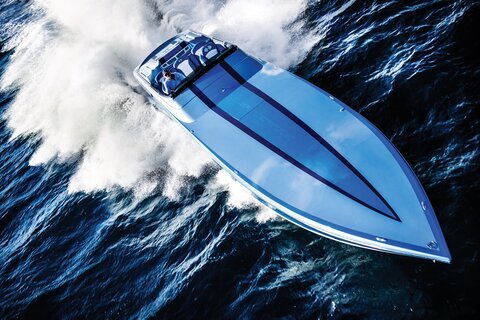
with local dealers to explore models and pricing in your area.
Explore Boat Brands
High Performance Boats
- Baja Marine
- Dave's Custom Boats
- Donzi Marine
- Formula Boats
Use our Boat Loan Calculator to get a better idea of your own budget.
Crunch the Numbers
Looking for a different boat?
Try our Boat Finder
Activities with High Performance Boats
GREAT FOR Day Cruising • Saltwater Fishing
While high performance boats are designed to deliver thrills at speed, there’s a lot more you can do with one than simply run fast. In fact, there is a whole host of organized activities for performance-boat owners around the country every season. The most popular of these activities are poker runs, which involve a fleet of performance-boats running from point to point to collect five cards. Participants play those cards at the end of the day to earn prizes and share good times with new and familiar friends. There also are brand-specific events year known as owner rendezvous organized by specific boat builders, as well as simple lunch runs and fun runs organized by various clubs around the country.
As Social Platforms
As enjoyable as organized events can be as social experiences, they’re not your only option with a high performance boat—at least if you chose a performance-oriented center console. Predominantly powered by outboard engines, the new generation of go-fast center consoles have abandoned their traditional angling setups for bountiful seating and open spaces in the cockpit. Models in this category range from 34 to 60 feet, which means they offer the most passenger seating and space of anything in the go-fast boat world. On the water or at the docks, a high-performance center can be the ultimate social platform for spending time with family and friends.
Ultimate Canvas for Customization
From paint to power, no powerboat category offers greater opportunities for customization than the high-performance realm. Elaborate, high-dollar paintjobs are more the rule than the exception in the upper end of the go-fast boating world, and most builders will even color-match a boat’s interior colors to those of its exterior. On the power side, buyers have an array stern-drive and outboard options depending on the model in question. Your options are, for the most part, only limited by your budget.
Ownership Costs of High Performance Boats
For the most part, high performance boat ownership tends to be significantly higher than those for other types of powerboats. New model prices start in the low six-figure range and can reach well past the $1 million mark. Because of their potentially high speeds—the fastest go-fast catamarans can top 180 mph—and powerful engines, high performance boats also tend to be substantially more expensive to insure than their conventional powerboat counterparts such as a bowrider or pontoon boat .
Our Boat Loan Calculator can help you determine if a high performance boat works for your unique budget and needs.
In the high performance boat world, the general rule of thumb is that the more-powerful the engines involved the more expensive the boat is to maintain. Service and rebuilds for big-power stern-drive engines of 1,000 horsepower and beyond are costly. Go-fast boats equipped with today’s reliable outboard engines are far less expensive to maintain and can be purchased with substantial factory protection, as long as eight years in some cases.
As a high performance-boat owner, your No. 1 operational cost will be fuel. The more powerful the engines involved, the more fuel they will burn and the higher-octane gasoline they will require for performance and reliability. Higher-octane fuel is more expensive than lower-octane fuel. Also, worth noting is that high-octane fuel tends to be less readily available on the water.
High Performance Boat Technology/Materials/Features
When it comes to construction materials used to build them, high performance boats run the gamut from vinylester resin and fiberglass to carbon fiber and epoxy. While the latter tends to be lighter, stiffer and equally strong, it also is more expensive than “conventional” fiberglass and resin materials still used by most builders.
Expect to find the latest electronics in today’s high-performance boats and you won’t be disappointed. Where once a speedometer and tachometer was everything an operator needed, current go-fast boats are loaded with the latest GPS monitors, accessory switching systems, live front-and-rear video cameras that display on screens in real time, massive stereo systems and in-cockpit and underwater LED lighting systems.
Explore Similar Boat Types
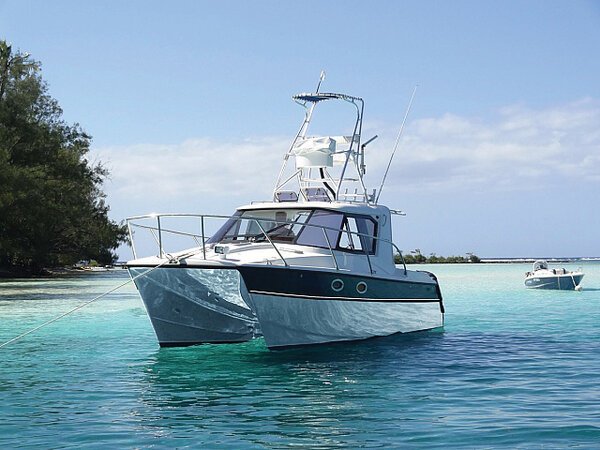
Multi-Hull Power Boat
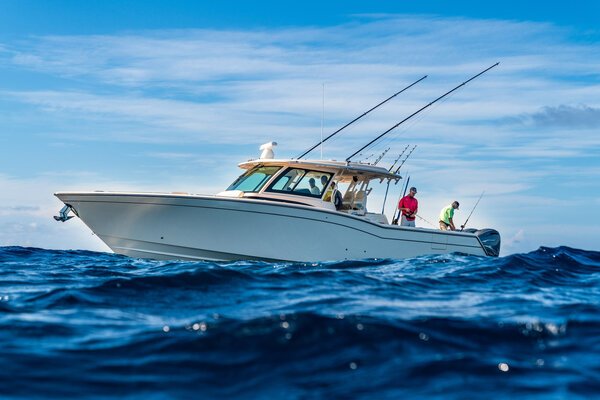
Sportfishing Yacht
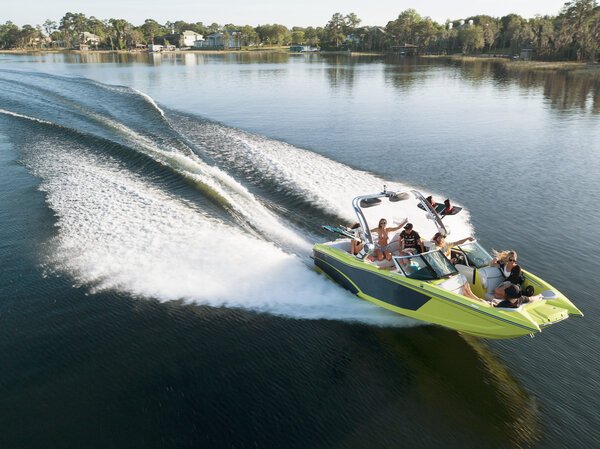
Ski Boat/Wake Boat
Join Our Newsletter!
Get community news, buying bargains, and how-to guides at your fingertips.
- 2024 BOAT BUYERS GUIDE
- Email Newsletters
- Boat of the Year
- 2024 Freshwater Boat and Gear Buyers Guide
- 2024 Boat Buyers Guide
- 2024 Water Sports Boat Buyers Guide
- 2023 Pontoon Boat Buyers Guide
- Cruising Boats
- Pontoon Boats
- Fishing Boats
- Personal Watercraft
- Water Sports
- Boat Walkthroughs
- What To Look For
- Best Marine Electronics & Technology
- Watersports Favorites Spring 2022
- Boating Lab
- Boating Safety

The History of Go-Fast Boats
- By Pete McDonald, Photos by John Linn
- Updated: March 24, 2011
The emerald-green waters of Florida’s Government Cut are calm when the engines of a long, slender boat start to rumble. The sound builds until, suddenly, the stiletto-shaped boat slices through the water, ripping long V-wakes that flatten out slightly as the speed increases fantastically. The boat zips through the Cut, looping north into two-foot swells, running along South Beach and finding its groove.
It’s a “go-fast,” a Sunsation 36 XRT, and it is perfectly in its element. So is Wayne Schaldenbrand, who built it. Nope, his boat is built in Michigan, but it’s here today, cutting through open water against the backdrop of Miami glitz.
This may be where modern offshore powerboats were born, but Schaldenbrand caught his bug for it from his grandfather, who hand-built Chris-Crafts and other mahogany treasures, then powered them with one or two of the biggest engines he could.
“My first speedboat ride was in one of those,” Schaldenbrand says. “It probably went 35 miles per hour.” That’s all he needed to launch him and his brother on a career of building and driving fast boats. He was where the heart of this sport still beats steadily with adrenalin and high-octane fuel.
The performance scene slipped beneath the mainstream boating radar the past few years, as the recession and outrageous fuel prices sent people away. But boats like the Sunsation, Formula’s FasTech 353 and the 50 Cigarette Marauder, which turned heads at the recent Miami International Boat Show, prove that performance boats are back. So too does the announcement from Mercury Racing of a new 1,100 hp engine, on the heels of last year’s 1,350 hp V-8. And that’s a good thing. The performance world has always pushed the envelope for all aspects of powerboating.
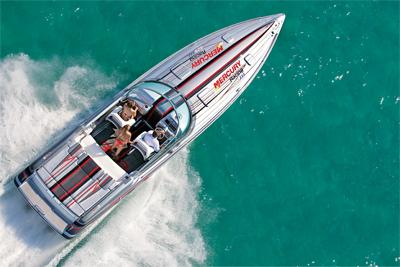
Speed Is Sanctioned Most boaters associate the offshore performance world with a clip from the opening credits of the 1980s TV show Miami Vice . Sonny Crockett had a Wellcraft Scarab 38. But the need for speed actually traces back to the turn of the 20th century.
The American Power Boat Association formed in 1903 and held its first race on the Hudson River in 1904. Despite holding the race in New York, the scene then revolved around the Michigan boatbuilders, in close proximity to the auto industry in Detroit. Much advancement came from the mind of the famous wood-boat builder Gar Wood, who pushed his designs to get more horsepower on board.
The offshore scene started, as it did for Wayne Schaldenbrand, in the 1950s, with many racers from hydroplane backgrounds; these endurance races ran for hundreds of miles and laid the groundwork for the future.
Offshore performance boating as we know it today emerged through a confluence of events and people in the mid- to late 1950s. Sam Griffith, who worked with yacht broker Richard Bertram, helped found the race that would define the go-fast genre. He, along with boatbuilder Forest Johnson (the father of the famed boating photographer), developed an offshore race between Miami and Nassau, Bahamas.
Miami-Nassau became the premier offshore race in the United States. For a while, it was the only offshore event. Winning it was akin to winning the Indy 500 — and the desire led Bertram to design a hull that changed boating forever.
The inspiration, it turned out, came from a sailboat race. In 1958, designer Ray Hunt’s 23-foot Aqua Hunter , a fiberglass support boat for the 1958 America’s Cup off Newport, Rhode Island, was making waves. The boat had 24 degrees of transom deadrise and lifting strakes, designed to handle the rough waters of offshore sailboat racing. Bertram asked Hunt to design a 30-foot version. The rest is history.
Legend has it that Bertram didn’t want to enter his wooden prototype, named Moppie after his wife, in the 1960 Miami-Nassau race, but Griffith talked him into it. With Griffith at the helm, they charged out into eight-foot swells and blew away every other boat. The second-place finisher, the other Hunt deep-V, Aqua Hunter , came in two hours behind. Most other boats did not finish. From here on, the deep-V ruled the world, and the racing community spent the next several decades figuring out what to do next from Hunt’s hull design.
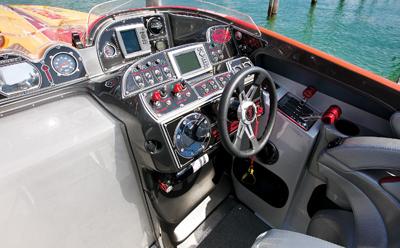
Trial and Error “During the 1960s, people tried absolutely everything to see what would work,” says Charlie McCarthy, a racer and boatbuilder who helped found the Historic Offshore Race Boat Association (HORBA). He tells the story of one builder running tests in Government Cut and saying, “This is it,” then pulling the hull and realizing the strakes had fallen off!
It was also around this time that a young real estate magnate from Brooklyn, New York, named Don Aronow moved to Miami and fell in love with offshore racing. Through sheer personality and determination, he became one of the top racers and a boatbuilder whose legacy is still felt today.
Aronow hooked up with two designers who would shape his early signature boats, Jim Wynne and Walt Walters. Wynne is the man responsible for bringing to market the other great innovation of the late 1950s, the stern-drive. Wynne had worked for Carl Kiekhaefer developing outboards with Charlie Strang, who originally pitched the stern-drive to Kiekhaefer, who rejected it. Strang and Wynne further pursued the idea, and when Wynne left the outboard company, he developed the first stern-drive in his garage and sold it to Volvo Penta, which released it in 1959 as the Aquamatic Drive.
Wynne and Walters helped Aronow design boats for his first company, Formula. McCarthy remembers walking into Aronow’s shop in a desolate area, one of only two buildings standing on 188th Street. This stretch would become home to many go-fast builders and be nicknamed “Thunderboat Row.”
Aronow had a 23-foot Formula inside that he had named the Cigarette . McCarthy would learn the name stemmed from a reported rum-running boat that ran in New York during Prohibition. Aronow had Wynne design the boat to compete in the 1963 Miami-Key West Race, one of the many competitions that emerged. Aronow himself would go on to win many races.
Eventually, the standard racing boat became the 24-degree, deep-V hull around 30 feet long, powered by twin gasoline stern-drives and staggered for weight distribution and to place the props closer together. The boats had a three-man crew — the driver, the throttle man and the navigator.
Aronow sold Formula to Thunderbird during this era and started a new company called Donzi. Then he sold Donzi and started Magnum Marine, where he teamed with designer Harry Schoell. To insiders, Magnums were game-changers.
“The defining boat,” says Allan Brown, a veteran racer, “was the 28 Magnum designed by Harry Schoell.” Aronow cut it down and sold it as the 27 Magnum, but to “Brownie” and others, the hull lived on through hundreds of copies.
By 1969, Aronow had sold off Magnum Marine and started racing a 32-foot Cary he also named the Cigarette . Aronow raced that boat to the 1969 World Championship and promptly retired from racing to start what became the defining brand of the go-fast world. You can guess the name.
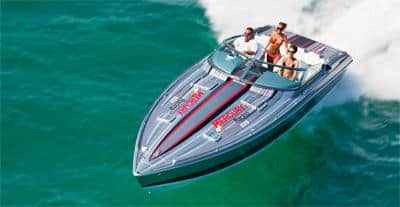
Bad Boys Were Good Business Miami Vice lives on beyond its time. Its portrayal of go-fast boats brought a new image to the scene. Like with Harley-Davidson motorcycles, enthusiasts flocked to brands like Cigarette and Scarab for the outlaw image. Doctors, lawyers and businessmen could get behind the wheel of a go-fast boat and feel like a bad boy.
Charlie McCarthy calls the decade of the 1970s the “golden era” of offshore performance boats. “Anyone could buy a boat off the street and be competitive,” he says. “If you were able to grit your teeth and hang on, you could win.”
Thunderboat Row became the epicenter of the race scene. Bertram was still heavily involved in racing and producing boats, and builders such as Formula, Donzi, Magnum, Apache, Cigarette, Tempest and, later, Cougar were going strong.
Innovations from the racing side began to spill into recreational boatbuilding, as pleasure-boat builders learned more and more. Pleasure boaters took to the idea of going fast, and performance boats gained traction in the public eye. In the 1980s, they’d gain notoriety for different reasons, though.
The trouble was, the outlaw image was real. Mainstream sponsors started abandoning the offshore race world, scared off by its drug-money affiliations. The world of performance boats also took a major hit when Don Aronow was murdered. It remained unsolved for a long time, spurring rumors of a mob hit or that Aronow was a victim of the Miami drug wars.
The deep-V racing scene took another hit at the hands of fast catamarans. “They just destroyed racing for a while,” says Allan Brown, because they won every race.
The cats could go significantly faster than the V-hulls in calm water. With their appearance, and with sponsorship opportunities dwindling, offshore racing went from a unified group under the APBA to several splinter organizations.
Go-fasts continued to have a strong recreational following, but the era of the classic offshore deep-V race seemed past.
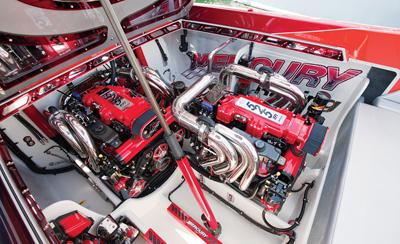
Gambling on Poker Runs Nothing could be further from the truth, though. Builders like Fountain, Formula, Baja and Donzi kept performance racing alive while bringing the recreational end to new heights in the 1990s and early 2000s.
Poker runs replaced racing as the focal point of the scene and represented a sea change in performance boating from the early years. While some old racers decry this development, poker runs may save the go-fast boat.
Most races field about 20 to 25 entrants; a major poker run will get 150 to 200 boats. Participants run — not race — to five different checkpoints and draw a playing card at each one. The person with the best hand at the end wins. “It’s the same type of thrill,” Lipschutz says, “but nobody argues over who wins.”
In the old days, you had to rebuild everything after every race, and a typical recreational performance stern-drive lasted 20 or 30 hours before breaking down. But today’s engines hold up, and the boats are built with lighter cored construction.
Indeed, Cigarette, Formula, Sunsation, Outer Limits and others all survived the recession. Baja, Donzi and Fountain have been resurrected under American Marine Holdings. and Reggie Fountain started a new company, RF Boats (which stands for “real fast,” not Reggie Fountain). Building is a different game. Of production go-fasts, Sunsation’s Schaldenbrand says, “Those days are about 80 percent gone.”
Schaldenbrand estimates he will build 12 36 XRTs this year. Overall, his company will build about 45 boats, down from around 80 in the early 2000s.
With or without poker runs, performance boats will always be around. Someone is going to get behind the wheel of a boat and make it run as fast as possible. As Schaldenbrand explains, “I was born with it. It’s in my blood somehow.”
Or, as Reggie Fountain once said, “It takes a lot of money to win offshore races, but as long as there’s somebody out there racing, I’m going to be out there kicking their asses.”
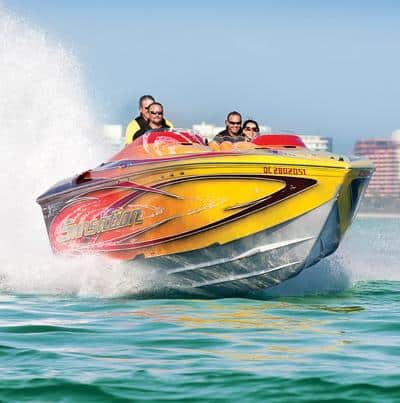
Game-Changing Design The biggest change in fast, deep-V hulls in the past 20 years has been the popularization of stepped hulls. Steps date back to the early days of powerboats in the 1900s, but they didn’t start to gain mainstream acceptance until builders like Reggie Fountain popularized them in the 1990s.
Phil Lipschutz, a cigarette dealer in Miami and a veteran racer, explains the allure of stepped hulls: “You can’t go if your propellers are in the air. With twin steps, a boat will lie in the water and hook up so much better. It’s faster and easier on the engines.”
Stepped-hull boats go 10 mph faster than a conventional V-hull with the same power, and they ride level. Early designs with large 21/2 -inch steps proved unpredictable and could catch and spin bow to stern. But most builders have honed the steps down to 11/4 inches, getting the same performance results with more stability.
The twin-stepped hull is now the dominant form in modern performance boats, such as the Sunsation 36 XRT. “We siphoned everything we could from high-end catamarans and aviation,” Wayne Schaldenbrand says. With twin 525s, the 36 XRT hits around 95.5 mph.
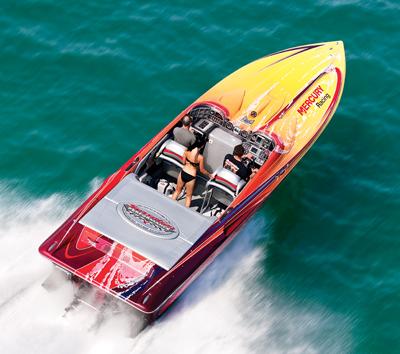
Carl Kiekhaefer & Mercury Racing One of the great ironies in boating is that Carl Kiekhaefer, the man who dismissed the idea of a stern-drive in the 1950s, became one of its biggest proponents in the 1970s. Kiekhaefer is famous for his revolutionary Mercury outboards, always pushing them to go faster at his mysterious testing center in Florida known as Lake X.
Kiekhaefer sold his outboard business to Brunswick in the 1960s and left the company in 1969. In the early 1970s, he went on to form Kiekhaefer Aeromarine Motors, which specialized in marine racing sterndrives. He applied the same demand for excellence there.
“One of the key guys he had was a kid named Richie Powers,” recalls Charlie McCarthy of the Historic Offshore Race Boat Association. “They’d go through engine after engine, blowing them out and tweaking them until they got 625 hp out of a 496 block.” When they finally got it, Powers asked Kiekhaefer, “Can I go home now? It’s Christmas.”
When Carl passed away, his son Fred took on the company and eventually sold it to Brunswick, which renamed it Mercury Racing. Fred Kiekhaefer is still very much involved as president of Mercury Marine.

- More: Boats , Performance Boats , Runabouts
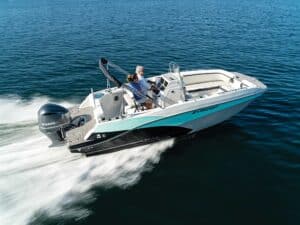
Boat Test: 2024 Starcraft SVX 231 OB CC
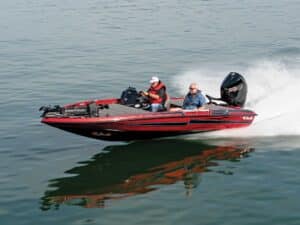
Boat Test: 2024 Bass Cat Caracal STS
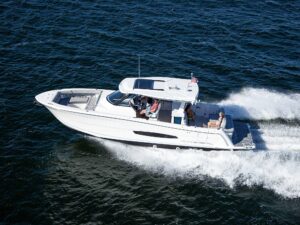
Boat Test: 2024 Regal 38 Surf
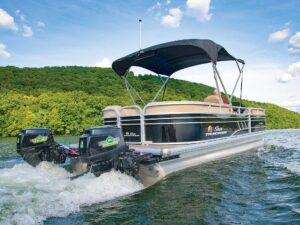
Using Hydrofoils to Improve Boat Performance
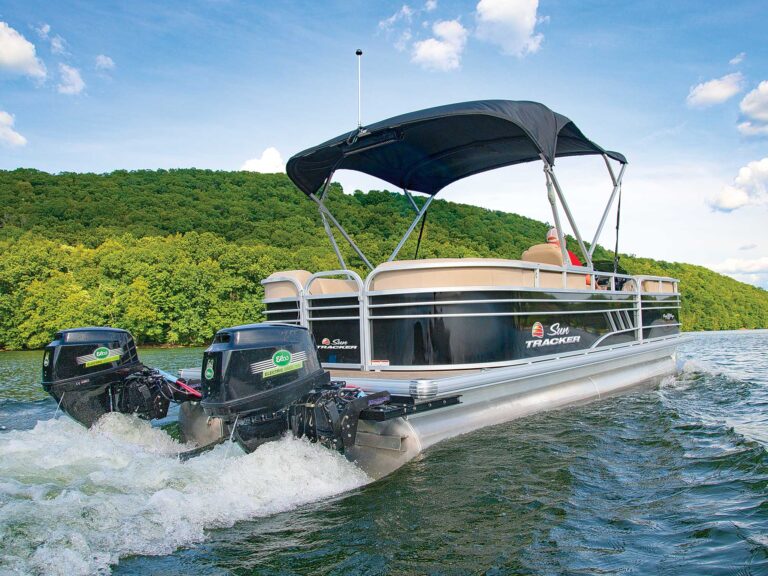
We Test Interlux Trilux 33 Aerosol Antifouling Paint

Boating Shoes for Spring and Summer

MasterCraft Celebrates International Women’s Day With Fourth Annual ‘Let Her Rip’ Campaign

- Digital Edition
- Customer Service
- Privacy Policy
- Cruising World
- Sailing World
- Salt Water Sportsman
- Sport Fishing
- Wakeboarding
Many products featured on this site were editorially chosen. Boating may receive financial compensation for products purchased through this site.
Copyright © 2024 Boating Firecrown . All rights reserved. Reproduction in whole or in part without permission is prohibited.

How Fast Do Catamarans Go?

Last Updated by
Daniel Wade
August 30, 2022
Catamarans are known for their speed, and some vessels are fast enough to break world sailing speed records.
Catamarans can go between 15 and 30 knots, with the fastest achieving speeds well in excess of 60 knots. Sailing catamarans are sometimes twice as fast as monohulls and cut through the water with greater efficiency.
In this article, we’ll cover how fast catamarans can go based on factors such as size, sail area, and design category. Additionally, we’ll compare catamaran speeds to monohulls and trimarans and cover the reasons why multi-hull sailboats blow monohulls out of the water.
We sourced the information used in this article from sailing guides and hull speed calculations. Additionally, we sourced information directly from the manufacturers of common catamarans.
Table of contents
Catamaran Speed by Type
Catamaran design can be split into different categories. After all, different vessels are designed for different tasks, as speed isn’t always the most important design consideration.
The fastest type of catamaran is the ultralight racing catamaran. These vessels have extremely narrow hulls and a remarkable planing ability. They’re designed to pierce waves and often achieve speeds in excess of 45 knots or greater, depending on conditions.
The second fastest catamaran variety is the sport catamaran. Sport catamarans often include a fairly good level of creature comforts in the cabin. They’re technically hybrid designs, because they are envisioned as a combination between a racer and a cruiser. Sport catamarans can achieve 30 knots or greater.
Cruising catamarans are designed primarily for safety and comfort. They’re often used for long offshore passages, where speed is important, but comfort is king. Despite their accommodations, cruising catamarans can still achieve a respectable 15 to 20 knots of speed—sometimes 50% faster than similarly-equipped monohulls.
Why are Catamarans So Fast?
Catamarans are remarkable vessels that can achieve amazing speeds. As a result of their unconventional design, typical calculations for hull speed (such as those used for monohulls) don’t always apply.
But what makes catamarans so much faster than equivalent monohulls? The first and most obvious speedy design element are the hulls themselves.
Catamarans don’t have a deep keel or a centerboard. This is because the second hull acts as a stabilizing device, and it helps the vessel track straight. The lack of a keel reduces weight (and equally important). It also reduces drag.
Additionally, catamarans behave in strange ways while underway. The hulls have a tendency to rise out of the water further the faster they go. This further reduces drag and makes it easier for the vessel’s speed to climb once it starts to move.
One additional characteristic is how the vessel’s sails point relative to the wind. Catamarans keep their sails perpendicular to the wind, which allows them to harness energy more efficiently. This is because, at a perpendicular angle, less wind energy is lost by spillage over the edge of the sails.
Are Catamarans Faster than Monohulls?
Yes, catamarans are typically faster than monohulls. They’re also a lot more stable, as their spaced-out hulls provide better motion comfort in rough seas. Catamaran hulls are narrower than monohulls, which also reduces drag and increases speed.
Catamaran vs. Monohull Speeds
We know that catamarans are faster than monohulls in most situations. But how much faster are they? Here’s a table of hull speeds for monohulls, which is a useful reference when comparing speed. Hull speed isn’t the absolute fastest that a boat can go, but it’s a good practical estimate for understanding the hydrodynamic limitations of single-hull designs.
Hull speed calculations for catamarans are more complicated. This is because catamarans have a greater length-to-beam ratio. And due to their narrow hulls and open center, they aren’t affected by the same hydrodynamic drag forces that monohulls are limited by.
For example, a 55-foot monohull sailboat with a waterline length has a hull speed of 9.4 knots or 10.9 mph. Its actual speed could exceed that in the right conditions, but rarely by more than a few knots.
Compare that to an efficient 51-foot catamaran, which can easily achieve speeds in excess of 20 knots in reasonable winds. That’s more than double the hull speed of a monohull with a similar waterline length and proves that catamarans operate under a completely different set of rules.
Wave Piercing
One aspect of catamaran design that makes them superior speeders is their ability to pierce waves. Specially designed catamarans have minimal buoyancy at the bow, which allows them to slice through waves instead of going over them.
This increases the speed at which catamarans can cover the distance. Think about it—a boat going over a wave has to use more energy to reach the same destination, as the height of the wave almost makes the distance further.
It’s like walking over a hill or on flat ground—you’ll take more steps walking up and down the hill than in a straight flat line. Wave piercing catamarans enjoy better stability, and they ‘take the flat road’ to a greater extent than monohulls.
Do Catamarans Plane?
Planing is when a boat’s hull rises out of the water due to hydrodynamic lift. This increases speed and efficiency, as there’s less drag but sufficient contact for stability. It also reduces rolling, as the bow only contacts the taller portions of the waves.
Catamarans have planing characteristics, but they generally don’t plane as dramatically as powerboats. This is still worth noting, as catamarans are specifically designed to use the phenomenon of hydrodynamic lift to gain speed and efficiency.
You’ll visibly notice a catamaran’s hull rising out of the water as it increases in speed. Compare that to a displacement monohull design (such as a classical cruising sailboat with a deep keel), which won’t rise out of the water in any significant way.
Are Catamarans Faster than Trimarans?
A trimaran is a catamaran with an additional hull in the center. Trimarans are usually less common than catamarans, but they have some of the same design benefits as other multi-hull sailboats.
At first glance, it would seem logical that trimarans are slower than catamarans. After all, they have an extra hull in the center, which likely increases weight and drag. However, there are more important factors at play here.
Trimarans are almost universally faster than catamarans. This has to do with weight distribution. Trimarans center their weight over the middle hull, using the outer hulls primarily for stability. This allows them to reap the benefits of a catamaran while increasing the efficiency of the wind power it captures.

Fastest Catamarans
Catamarans are popular for racing. There are several world records held by catamarans and numerous production boats with especially impressive speed-to-size ratios. Here are a few of the fastest racing and production catamarans ever built.
Fastest Sailboat Ever—Vestas Sailrocket 2
The Vestas Sailrocket is a specialized racing boat designed only for speed. This incredible vessel is actually the fastest sailboat ever built—and no wonder it’s a catamaran. A monohull simply can’t achieve record-breaking speeds when put head-to-head with a lightweight multi-hull.
The vessel, which earned the world sailboat speed record in 2012, has a modest 150 to 235 square feet of sail. Nonetheless, it managed to achieve a remarkable top speed of 65.45 knots in only 25 knots of wind. That’s about 72 miles per hour—in a sailboat.
Soon, a team of Swiss engineers will release their own version designed to beat the 65-knot speed record. Their vessel, which is a hydrofoil, will attempt to hit an incredible target speed of about 80 knots.
Outremer Catamarans
But what about production catamarans? How do they stack up, and how fast can they go? French boat builder Outremer Catamarans builds some of the fastest production catamarans ever built. These are not specialty racing boats—in fact, they’re average-sized cruising catamarans.
Let’s use the larger Outremer 51 as an example. This high-end cruising cat is known for its almost outrageous speed capabilities. In ideal conditions, owners of the Outremer 51 have reported speeds exceeding 20 knots for extended periods.
That’s a production catamaran with speeds that rival 20th-century warships. With such a fast boat, the world’s oceans start to appear a lot smaller. Plus, the genius design of the Outremer 51 allows it to be crewed by just two people.
But how do Outremer catamarans achieve such high speeds? The secret is in precise engineering and hull design, along with a sail plan that’s perfectly catered to the vessel. The hulls are sleek and narrow and designed to cut through the water with minimal drag.
From the bow, the Outremer 51 hulls look paper-thin. They increase in width gradually, which eliminates areas of sudden drag. These narrow hulls evenly distribute the vessel’s 21,825-lb displacement. Its low-buoyancy bows reduce drag and blast through waves instead of riding over them.
Related Articles
I've personally had thousands of questions about sailing and sailboats over the years. As I learn and experience sailing, and the community, I share the answers that work and make sense to me, here on Life of Sailing.
by this author
Learn About Sailboats
Most Recent

What Does "Sailing By The Lee" Mean?
October 3, 2023

The Best Sailing Schools And Programs: Reviews & Ratings
September 26, 2023
Important Legal Info
Lifeofsailing.com is a participant in the Amazon Services LLC Associates Program, an affiliate advertising program designed to provide a means for sites to earn advertising fees by advertising and linking to Amazon. This site also participates in other affiliate programs and is compensated for referring traffic and business to these companies.
Similar Posts

Affordable Sailboats You Can Build at Home
September 13, 2023

Best Small Sailboat Ornaments
September 12, 2023

Discover the Magic of Hydrofoil Sailboats
December 11, 2023
Popular Posts

Best Liveaboard Catamaran Sailboats
December 28, 2023

Can a Novice Sail Around the World?
Elizabeth O'Malley
June 15, 2022

4 Best Electric Outboard Motors

How Long Did It Take The Vikings To Sail To England?

10 Best Sailboat Brands (And Why)
December 20, 2023

7 Best Places To Liveaboard A Sailboat
Get the best sailing content.
Top Rated Posts
Lifeofsailing.com is a participant in the Amazon Services LLC Associates Program, an affiliate advertising program designed to provide a means for sites to earn advertising fees by advertising and linking to Amazon. This site also participates in other affiliate programs and is compensated for referring traffic and business to these companies. (866) 342-SAIL
© 2024 Life of Sailing Email: [email protected] Address: 11816 Inwood Rd #3024 Dallas, TX 75244 Disclaimer Privacy Policy

My Cruiser Life Magazine
Sailing Catamaran Speed
You’ve probably heard that one of the best reasons to get a catamaran is because they’re fast. After all, there’s a race any time there are two sailboats on the same waterway.
But like all things in boating, speed is a relative term. Catamarans seem fast to those coming from slow and heavy monohull sailboats, but cruising catamarans are still pretty slow vessels. There are indeed high-tech racing catamarans breaking speed records all the time. Still, the vessels that most liveaboard cruisers venture out on are only slightly faster than their monohull counterparts.
For this article, we will look at the types of catamarans people live on and cruise on. Forget about those fantastic America’s Cup yachts or those multihull go-fast fishing boats for a few minutes.
I have had experience cruising and living aboard both catamarans and monohulls. For five years, my wife and I enjoyed catamaran sailing on a Lagoon 380. We then switched—for many reasons—to a Cabo Rico 38. The Cabo Rico is a traditionally-designed monohull with a full keel and a heavy displacement. In other words, it’s about as far away from a “speedy” catamaran as one can get.
Table of Contents
How fast can a catamaran go, measuring catamaran speed, catamaran speeds vs monohull speeds, sailing cruising catamarans, performance cruising catamarans, racing catamarans, power cruising catamarans, catamaran top speed, faqs – how fast are catamarans.
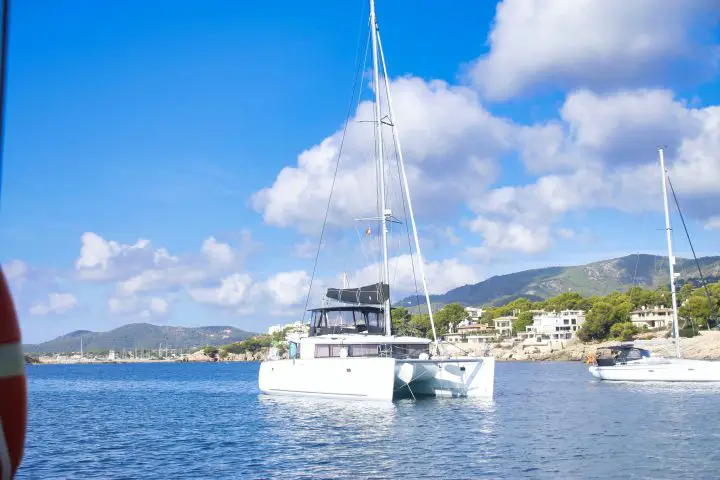
There’s no doubt that catamarans are some of the fastest sailboats around—but there’s also a lot of misinformation and misunderstanding online about how fast they really are.
Realize that not all catamarans are created equally. There are cruising catamarans built to carry their passengers in comfort. And then there are racing catamarans built for nothing but speed. Somewhere in between, there is a poorly-defined category of “performance cruising” catamarans that stir passions.
So, are catamarans fast? Well, it’s all relative. But, if you compare them to monohull sailboats of similar sizes and capabilities, the catamarans are usually faster for several reasons.
The speed difference is even harder to measure in the cruising catamaran category. One of the reasons catamarans beat monohulls during races is because they are built light with no ballast. But a heavily-laden cruising cat ready for an ocean crossing is hardly “lightly loaded.” Will it still beat a similarly heavily-laden monohull? Sure! But probably not by as much as you might think.
Boats measure their speed in knots. Traditionally, this was measured by a tool known as a knot log. The modern equivalent is an underwater instrument with a spinning wheel that effectively measures the speed of the water passing over the hull. So long as no currents are present, that speed will equal the boat’s speed over the ground (SOG).
Satellite navigation allows us to measure our SOG more accurately, but this isn’t a great indication of boat performance since it will be affected by tides and ocean currents.
For landlubbers, one knot is equal to about 1.15 statute miles. So, in other words, when we say that a sailboat cruises at 6 knots, it means it’s going about 7 mph.
But before going any further, consider this—the maximum speed that a sailboat makes is generally a pretty meaningless number. Maybe the knot log pegs to 13 knots for a few seconds, thanks to a strong gust of wind while you’re headed down a large swell. Does this mean you’re driving a 13-knot boat?
A voyaging sailor who has made a long passage will have little interest in this sort of number. When you’re crossing oceans, what really matters is how many miles pass under the keel each day. The more miles you tick off, the shorter the passage. So most sailors learn quickly to look past the “fastest speed in knots” number and find real-world stats on passage miles.
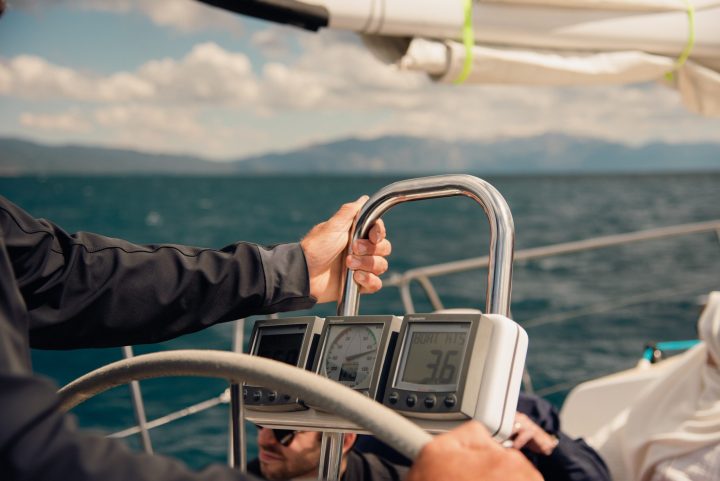
Comparing speeds between radically different sailing vessel hulls is like comparing apples to oranges. Even seemingly similar boats, like “cruising sailboats,” the differences between one and the other are endless.
For example, let’s say you wanted to compare 38-foot monohulls to 38-foot catamarans. The speed of a monohull is limited by waterline length, which means you’d have to look at a hull that is significantly more than 38 feet in most cases. On the other hand, the catamaran is known for long swim platforms on inverse transoms and plumb bows—meaning most 38 foot cats have nearly 38 feet of waterline.
Then, what sort of hull design makes a fair comparison to a catamaran? Would it make sense to compare a transitional, salty 38-footer with a full keel? Probably not. Most sailors interested in the cruising catamaran lifestyle would more than likely be comparing it to a modern monohull with a flatter bottom, fin keel, and spade rudder.
What about the catamaran? There’s a lot of variation in the catamaran field regarding performance. If speed is your goal, you likely want to compare the high-end performance brands—Outremer, Gunboat, HH, and the like. These boats are becoming more popular, but most cruising cats you see on the water are not performance models. Instead, they are the big and comfortable cruisers made by Lagoon, Leopard, or Fountaine Pajot.
Finally, how can you fairly compare the stats? Boats sail differently in different wind speeds and at different points of sail. In other words—there are a lot of variables that make it hard to answer the question, “How fast can a catamaran go?”
Polar charts for each vessel can provide some clues to make a somewhat fair comparison. Polar charts are graphical plots of a sailboat’s performance in different wind conditions and at different points of sail. Manufacturers seldom publish since no two are ever perfectly alike. They are less of a boat specification and more of one sailor’s results for a particular boat. Most owners make their own polar diagrams, but they’re still a tool for those looking to get an idea of a model’s performance in the real world.
Speeds of Various Types of Sailing Catamarans
There are several distinct catamaran classes, and predicting speed means understanding what the designers were building the craft to do. You might be surprised to learn that the first “modern” catamarans popped up in the New England racing circles in the late 1800s. Nat Herreshoff’s Amaryllis is particularly famous from the time .
Since then, catamarans have been synonymous with speed. But in today’s world of many different multihull designs, it’s important to set your expectations accordingly. As you would not buy a Ferrari for its cargo space, don’t expect your minivan to win any races at the track.
Examples of cruising cats include popular models made by the big-three catamaran makers—Lagoon, Fountaine Pajot, and Leopard. However, there are dozens of other companies making these boats. The market and industry for cruising catamarans have never been larger.
Most of these boats are engineered to provide comfortable accommodations for voyaging. They first became famous as vessels for sail charter holidays, where their huge cockpits and private cabins made them much more popular than the smaller and cramped monohull options.
As a result, they’re not built with high-tech components or super lightweight performance rigs. Instead, they’re the catamaran equivalent of a Hunter or a Catalina sailboat—mass-produced on an assembly line. That keeps prices lower than other types of catamarans, but it also means that they’re not winning any races. The makers use traditional layups with end-grain balsa-cored fiberglass to keep costs down. In addition, they usually feature stub fin keels, which are foolproof to sail but will not provide the upwind performance of a lift-making daggerboard.
Still, without ballast and when lightly loaded, cruising catamarans can move. They show their colors in light air when heavy displacement-hulled sailboats usually make their poorest showing. Since these moderate conditions also make for great cruising, these boats can provide a lovely ride in smooth weather.
Cruising catamarans can’t plane or anything, but their narrow hulls create an effect that means they can beat the hull speeds of a similarly sized monohull. Of course, it’s not a precise number since every boat and crew is different, but generally, you could expect speeds to be about one and a half times that of a same-sized monohull.
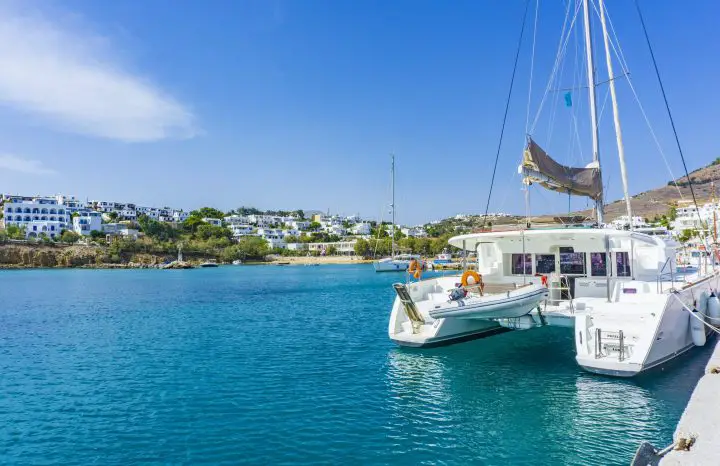
These catamarans are still rigged for comfort, but they’re built using the highest-quality and lightest-weight materials. While their hulls are rigged for comfortable living, they are generally designed much sleeker than regular charter-style cruising catamarans. The hulls are narrower, and you’re unlikely to see tall flybridges or forward lounge seating.
Several companies are making these boats. But in the world of catamarans, a performance cruiser is the upper end of the market. If you want a car comparison, Lagoons are something like a Chevy sedan, whereas an Outremer is like an M-series BMW. A Gunboat would be even more exotic, like a Ferrari. Not only are they more fashionable brands, but they’re also made to higher standards with cutting-edge designs .
It’s also worth noting that the category of “performance cruising cat” is a sliding scale. Some companies make vessels with better materials and craftsmanship than the cruising cats but aren’t designed for speed. Others build cats that are all about performance with few amenities.
With every new model, companies building these cutting-edge boats are attempting to boost the “performance” and the “cruising” aspect of their vessels. As a result, amenities and speed continue to get better and better.
Any racing sailboat is not designed for comfort. Especially on a catamaran, accommodations take up space and weigh the boat down. True racing vessels are designed to not worry about the crew but optimize every element for speed. Once the boat is designed for the desired performance, they’ll squeeze in bunks and storage wherever they can.
As such, there’s not much point in comparing them to liveaboard or cruising sailing vessels—they are too different. Some modern racing catamarans even fly above the water on foils. This makes for a high-speed boat and a considerable risk for sailors traveling for pleasure. Gunboat tried to make a foiling cruising cat in the G4 model, but it didn’t go so well for them.
Power cats run the same gamut of designs that sailing catamarans do. Power catamarans and sport catamarans designs are popular in powerboat circles for the same reasons they are in the sailing world–their hull designs allow for smaller underwater profiles and high speeds. There are many fast catamarans out there with twin engines and average speeds of well over 70 knots. Most recreational vessels cruise at about 20 knots, however.
Power catamarans also offer a smooth ride, making them a popular choice for large vessels like passenger ferries. There are even military vessels that use two hulls, like the stealth M80 Stiletto .
As you can see, catamaran speeds vary from just slightly better than monohulls to extraordinary flying machines. But cats are about much more than just speed. Their open and bright living space makes living aboard an entirely different experience than living on a monohull. Their cockpits flow into their salons for a full-time outdoor living feel that no other type of vessel can match. There are many reasons to choose a catamaran as a liveaboard sailboat.
How fast is a catamaran?
The answer depends on many other questions, like what sort of catamaran is it? And if it’s a sail cat, how fast is the wind blowing?
Sailing catamarans come in all different shapes and sizes. Some are optimized for living space and comfort, while others are designed with fast cruising speeds being the sole goal of the boat. The Gunboat 68, one of the fastest cruising sailboats currently made, can exceed 30 knots.
The world of power cats is much the same. Some power cats can do well over 70 knots, while most cruising boats top out at around 20 knots.
Do catamarans have a hull speed?
A hull speed is a characteristic of traditional displacement-hulled sailing vessels. The properties of the hull shape under the water create drag that limits the overall speed that the vessel can achieve. Even if you keep adding more power (or more wind), the vessel cannot exceed its designed hull speed for any length of time. Hull speed is a factor of waterline length.
Multihulls, however, have an entirely different underwater profile than monohulls. Their narrow hulls and shallow keels mean that drag is not the limiting factor. With this in mind, designers can tweak catamaran hulls to plane and cruise well above the hull speed of a similarly sized monohull.
What is the fastest cruising catamaran?
The market for fast-moving cruising cats has never seen more innovation than in the past decade. This type of boat has taken off, spurred in part by new designs and the overall popularity of multihulls for cruising. The industry leader in fast multihulls is generally considered the French-based company Gunboat . After all, one of the company’s mottos is “Life is too short to sail a slow boat.”
The company’s largest boat to date is the Gunboat 90 Sunshine . However, the delivery of the company’s current flagship, the Gunboat 68 Condor , from France to St. Maarten, provides some real-world numbers. In the delivery crew’s words, “Our max speed exceeded 30 knots a couple of times, and the max 24-hour run was 328 nm.” To save you the math, that works out for an average speed of 13.7 knots for their best day.
Matt has been boating around Florida for over 25 years in everything from small powerboats to large cruising catamarans. He currently lives aboard a 38-foot Cabo Rico sailboat with his wife Lucy and adventure dog Chelsea. Together, they cruise between winters in The Bahamas and summers in the Chesapeake Bay.
More From Forbes
3 types of go-fast narco boats the coast guard faces.
- Share to Facebook
- Share to Twitter
- Share to Linkedin
On July 29, a U.S. Coast Guard detachment aboard the U.S. Navy Arleigh Burke-class guided-missile destroyer USS Nitze (DDG 94) interdicted a power boat loaded with illegal drugs. Then on August 19, the Colombian Coast Guard, aided by the Colombian Navy and unspecified intelligence sources, intercepted another loaded with cocaine in the Pacific. The two successful missions illustrate a phenomenon which the U.S. Coast Guard calls Go-Fast Vessels (GFV).
Colombian forces recovered a customized go-fast loaded with cocaine on August 19. This represents ... [+] the high-end of go-fasts and is easily mistaken for a narco-submarine.
Media tends to focus on so-called ‘narco submarines.’ The latest one destroyed by the Colombian Navy was a monster , about 100 feet long. Yet while narco-subs are exotic, the more basic go-fasts are also engineering curiosities and deserve more attention.
Go-Fast narco boats are also customized for drug running. There are different types facing the law enforcement and navies as they enforce U.S. Southern Command’s (SOUTHCOM) ‘enhanced counter-narcotics operations.’
A working definition of a go-fast is a power boat which primarily employs speed to evade capture. By contrast narco submarines use their low profile to avoid detection. So it is speed versus stealth. The narco subs can generally carry more drugs and are harder to counter, but they are more difficult and expensive to build. Of course there is a gray area where the most elaborate go-fasts start to look a lot like some narco submarines.
Let’s look at the three basic types faced by the Coast Guard and other law enforcement agencies today.
As Blue Beams Rain In Helldivers 2 There s One Player On The Cyborg Homeworld
Ukraine s seven ton strike drones are back in action, three killed in philadelphia suburb shooting spree police say gunman is barricaded in new jersey residence, customized go-fast vessels.
These are the elaborate type where efforts are made to increase seaworthiness and, to an extent, reduce detection. See photo above. Generally they take a large power boat hull and cover the front half with fiberglass. This is where a lot of the drugs and fuel are carried. They can have several outboard motors, or sometimes larger inboard motors. The main visible distinction from narco submarines is that they most often have an open cockpit. This would not work if they were running semi-submerged like a narco sub. The one intercepted by Colombian forces on August 19 was one of these.
The Coast Guard Cutter Stratton (WMSL 752) stopped this drug smuggling go-fast vessel in the Pacific ... [+] on May 31. It was loaded with 1,500 lb of cocaine. Note the additional space outboard motors.
Classic Go-Fast Boat
Going back to the 1980s, drug smugglers have used ‘cigarette boats’ to ferry drugs in the Caribbean. Originally they headed straight to U.S. shores but due to increased law enforcement focus in the 1990s they now mostly head to Mexico. From there the drugs are transported overland into America. The basic idea is to take a power boat, load it with enough fuel and then go as fast as you can.
Go-slows are open top fishing vessels used to smuggle drugs. 'Slow' is a relative term and they can ... [+] actually be quite fast. Their main distinguishing characteristic is that they do not have additional motors to radically increase the speed. This helps them blend in to legitimate fishing traffic.
Despite their nickname, these are also quite fast. These use a ‘panga’ or ‘yola’ fishing boat hull. Often additional outboard motors are added to give it more speed, but usually they are single motor. The basic idea is to blend in with fishing vessels. Plus the virtually unsinkable panga hulls make it much safer if something goes wrong. In practice these sometimes operate in groups with a larger ‘mother ship’ towing them much of the way. It is therefore a more sophisticated operation than the classic go-fasts.
- Editorial Standards
- Reprints & Permissions

How Fast Do Catamarans Go? 5 Examples (With Pictures)
A catamaran is generally more balanced on the water and can be faster than a multi-hull vessel.
Unless you compare them to foiling monohulls like the new America’s Cup boats that sail at over 50 knots, they are not recreational vessels.
In this article, we will look at how fast each type of catamaran will go.
Table of Contents
Here are the numbers before we dive into the details:
Average Speed For Sailing Catamarans
Catamarans can vary in size from 14 ft to over 100 ft. Catamarans can come in a wide variety of design types.
Sailing Catamarans have been attempting to make advancements over their mono-hulled counterparts.
These advancements include:
- Foils that assist with lifting the vessel out of the water.
- Stability advancements.
- Racers that can maintain their speed while out in the ocean.
3 Different Types of Sailing Catamarans:
1) sport catamarans.

One type of sailing catamaran is a sport catamaran, which is otherwise known as recreational. These are typically supposed to have a small crew and launch and land on beaches.
Sport catamarans do not normally have living quarters and are ideal for day trips. Resorts or other rental services often use these.
These can also be used for racing.
Sport vessels have been known to travel over 30 knots but can speed over 40 knots in the proper conditions.
2) Cruising Catamarans

Another type of sailing catamaran is a cruising catamaran. These often come with complete living accommodations, so they sacrifice speed over their sportier counterparts.
They can average between 9 and 10 knots, depending on the conditions. The top speed is typically around 15 knots.
It would be best if you were careful with catamarans that have living quarters. The more you weigh it down, the less speed you will have.
3) Racing Catamarans

The final type of sailing catamaran is an ocean racing catamaran.
These boats are large and can reach over 100 feet in length.
The top speed of this type of catamaran is around 45 knots.
Because of the prize money for entering these in races, much research goes into their advancement.
Average Speed Of Power Catamarans
Catamarans with power motors fill a different type of boating category.
These are commonly used when speed and smoothness are favored over space or capacity.
Because of their stability, catamarans are good vessels for combating seasickness as well as transportation. We have a separate article here with all you should know about catamarans and (how to overcome) seasickness .
On a commercial level, these can be used for ferries for both people and vehicles. They are used for short term travel, often to or from islands.
Like sailing catamarans, there are a few types of power catamarans.
1) Power Cruising Catamarans

Similar to sailing cruising catamarans, they also have power cruising catamarans. These also have living quarters and are stable while out on the water. The speed of these vessels highly depends on the motors equipped and the size of the boat itself.
Like passenger transport or ferries, catamarans have a high speed of about 40 to 70 miles per hour.
These are made to travel at great speeds to allow their commuters the shortest possible ride to their destination.
The military also utilizes power catamarans. They use power catamarans to transport military cargo. These ships are ideal because of their speed, holding capacity, and ability to venture into shallow ports.
2) Swath Catamarans

They also have small-waterplane-area twin-hull vessels. These are called SWATHs.
These differ from the average catamaran because they also have submarine-like hulls that stay completely under the water.
Due to the hulls being submerged, they are not normally affected by waves. These are used most often in the ocean as research vessels. They can also be used for certain types of yachts. Because of their stability, they are good vessels for furniture that will not require as much securing.
These often travel between 20 and 30 knots.
Some catamarans are designed for wave piercing. These are made to pierce through waves rather than sail over them, causing them to be faster. These can be used as passenger ferries, yachts, and military vessels as well.
3) Whitewater Catamarans

There are also recreational catamarans made for whitewater travel. These are sometimes called “cata-rafts.”
They are made using two inflatable hulls connected with a scaffold. These are lightweight and perfect for whitewater sports.
They are even able to be packed away in a backpack. They can take up to 20 minutes to assemble, including inflation.
They have high speeds on white water rivers and can be most compared to a canoe, kayak, whitewater raft, or other white water vessels.
Performance Characteristics Of Catamarans
Catamarans require four times the power to double their speed. A mono-hull vessel, however, would require eight times the power to double their speed.
This is because a Catamaran has less resistance in the water.
This is also good for conserving and using less energy.
Catamarans are also more stable in the water. This stability is effective at resisting heeling or capsizing. A multi-hull vessel would require four times the force to capsize as a similar-sized mono-hull vessel.
The general sailing in a catamaran is smoother and allows for activities that are not always possible on a mono-hull sailboat.
Are Catamarans Faster than Mono-Hull Vessels?
Because catamarans have less water resistance, they are generally faster than mono-hull vessels.
This is because their hulls are smaller, which means they have a smaller bow wave to fight.
A bow wave is a wave created by the displacement of water by the bow of a ship. After a certain speed, a boat has to start hauling itself over its own bow wave.
The larger hull a ship has, the larger its bow wave will be and the more power required to fight it.
Catamarans have two small and narrow hulls, so they do not have much of an issue with their bow wave. This is one reason they are usually faster than a similar-sized mono-hull vessel.
Catamarans can be between 20-30 percent faster than their monohull counterparts.
Issues with catamarans over mono-hulls are that they can take more time to turn.
How Is The Speed Measured?
Boats commonly measure speed using GPS tracking devices to measure distance traveled. Speed while sailing is measured in knots. A knot is one nautical mile per hour, which equals about 1.15 miles per hour.
How Fast Are Catamarans Compared To Other Boat Types?
- Sailing catamarans typically average about 10 knots.
- Pontoon boats average about 20 mph.
- A powerboat cruiser can average anywhere between 30 and 50 mph.
- Cigarette boats can even reach close to 90 mph in the proper conditions.
- Sailboats average between 6 and 12 mph depending on wind conditions. This includes mono-hull between 6 to 8 mph and catamarans and trimarans between 9 and 10mph
Two different factors can determine the speed of sailing ships:
1) The hull type as listed above.
Different hulls rest in the water more or less than other types. The less of the hull that is underwater, the faster it can go.
This is because the less of the hull in the water, the less drag created while sailing.
2) The length of the boat
The longer the boat, the faster it can go. Every boat has a maximum hull speed that cannot be exceeded unless the boat can plane on the water’s surface or be lifted on hydrofoils. For most boats, the longer the boat, the higher the maximum hull speed is.
Speed Vs. Comfort Considerations For Catamarans
If you are looking for a catamaran, you have a lot of options.
You can choose to prioritize speed or comfort.
After deciding to purchase a catamaran, the type of catamaran you should look at depends on where and what you are using it for.
You will want to make sure that you look at what type of water you will be traveling in, how many people you are traveling with on average, and what type of speed you hope to achieve.
One thing you will want to keep in mind before the purchase of a catamaran is storage. If you intend to store your boat in a marina, you are often charged for two slips due to the beam, or width, of a catamaran versus the standard mono-hull vessel.
Catamarans can be beneficial for those who get seasick because they offer a steadier ride and the ability to have more open air space. Because the living quarters are not inside the hull and under the water’s surface, you have more windows and visibility.
Both sailing and power catamarans are viable options. Also, sailing catamarans can come with back-up power engines for low winds or situations such as docking in a marina.
Catamarans that have twin engines can offer more control and precision than those on a mono-hull vessel. This is good for tight and busy areas or navigating marinas.
Overall, there are plenty of options for you, and they offer many benefits over their mono-hull counterparts.
Click to share...

IMAGES
VIDEO
COMMENTS
For many, high performance boats are the most fun way to experience the water. Often referred to as go-fast boats or speed boats, these vessels embody the pinnacle of marine engineering, offering unparalleled speed, agility, and power on the water. Designed with sleek, aerodynamic lines and equipped with high-powered engines, these boats are ...
Go-Fast Catamarans. Today's most popular go-fast catamarans range from 28 to 52 feet. Powered by twin inboard engines up to 1,750-HP, they can reach 180 MPH and beyond. Once again, it goes without saying—but still needs to be said—that boats in this rather extreme category take years of experience to learn to handle safely.
Go-fast boats are the stuff of legend. You could be in a marina with luxury yachts and sailboats, and the high-performance powerboats would always garner the most attention. The faster the better, and if yours can top 100 mph, you've really got something special. Let's take a look at: The History of Fast Boats; High Performance Boat Types
Historically, however, Catana has made many beautiful boats. Notably, the 471 is a fast cruising catamaran that is a favorite among long-distance cruisers. On the smaller side, the 431 and even the 401 and 381 are quick and fun sailers that move better than their competition.
Still, cruising catamarans can be great racing boats, but just how fast can they go? Some of the fastest cruising catamarans include the Gunboat 68 (35 knots), Outremer 45 (25 knots), ORC50 (25 knots), FastCat 435 (20 knots), TS 42 (35 knots), and Lagoon 440 (20 knots). Yet, there are many more cats that can reach 35 knots safely.
They're all expensive—think $120,000 and up for a new go-fast powerboat. At the highest of the high end, something on the order of, let's say, a 50-foot enclosed-cockpit, all-carbon-fiber catamaran with twin 3,000-hp turbine engines and 200-plus-mph capability, you're looking at more than $1 million. In short, go-fast boats are not for ...
The New Trendsetters Sport catamarans are the latest sensation in the go-fast boat segment. These agile boats, ranging from 28 to 38 feet in length, are powered by twin outboard racing-style engines, providing exceptional speed and maneuverability. With top speeds reaching up to 130 MPH, sport catamarans have captured the hearts of speed ...
A pair of 1,350-hp turbocharged engines from Mercury Racing are under the hatch of the 43-footer. Frisini's largest model at 42 feet, 8 inches with an 11-foot, 8-inch beam, the catamaran was tested the week before Desert Storm in the waters off Miami by John Tomlinson, the famed offshore racing world champion who co-owns Miami-based TNT ...
High Performance Boat. 8 passengers max. 16 - 24 ft long. Trailerable. High performance boats are the best way to go for boaters who enjoy a bit of speed on the water and wind in their hair. Performance-oriented powerboats range in size from 20 to more than 50 feet and ride on V-bottom and catamaran hulls.
Custom builders who formerly produce nothing but dedicated go-fast boats began adding center consoles based on their existing, and in some cases brand-new, high-performance stepped hulls. No longer called the 39 Top Fish, Cigarette's 39-footer now has 41- and 42-foot siblings. Nor-Tech Hi-Performance Powerboats offers center consoles from 34 ...
By 1969, Aronow had sold off Magnum Marine and started racing a 32-foot Cary he also named the Cigarette. Aronow raced that boat to the 1969 World Championship and promptly retired from racing to start what became the defining brand of the go-fast world. You can guess the name. The History of Go-Fast Boats John Linn.
Go-Fast Catamarans. Today's most popular go-fast catamarans range from 28 to 52 feet. Powered by twin inboard engines up to 1,750-HP, they can reach 180 MPH and beyond. Once again, it goes without saying—but still needs to be said—that boats in this rather extreme category take years of experience to learn to handle safely.
A "go-fast" is a preferred boat for smugglers. A go-fast boat is a small, fast power boat designed with a long narrow platform and a planing hull.. During the United States alcohol prohibition era, these boats were used in "rum-running", transferring illegal liquor from larger vessels waiting outside US territorial waters to the mainland. Their high speed enabled them to avoid interception by ...
Go-Fast Catamarans. Today's most popular go-fast catamarans range from 28 to 52 feet. Powered by twin inboard engines up to 1,750-HP, they can reach 180 MPH and beyond. Once again, it goes without saying—but still needs to be said—that boats in this rather extreme category take years of experience to learn to handle safely.
Prices for high performance boats on Boat Trader range from a reasonable $13,379 at the bargain side of the spectrum to $2,713,542 for the more sophisticated crafts. While affordable utility models may have engines with as modest as 200 horsepower on them, models with more power can have motors up to a blazing 3,100 horsepower (although the ...
Consider this: Running at 50 MPH you cover 73 feet per second. At 100 MPH, not an unusual speed for a go-fast V-bottom or catamaran, you cover 146 per second. At 150 MPH—in range of many high-performance catamarans and even a V-bottom or two— you cover 220 feet per second. Distraction of any kind is something you simply don't have time for.
August 30, 2022. Catamarans are known for their speed, and some vessels are fast enough to break world sailing speed records. Catamarans can go between 15 and 30 knots, with the fastest achieving speeds well in excess of 60 knots. Sailing catamarans are sometimes twice as fast as monohulls and cut through the water with greater efficiency.
With all the different types of boats out on the water, you need something that will not only set you apart from the crowd but leave them speechless in your ...
For this article, we will look at the types of catamarans people live on and cruise on. Forget about those fantastic America's Cup yachts or those multihull go-fast fishing boats for a few minutes. I have had experience cruising and living aboard both catamarans and monohulls. For five years, my wife and I enjoyed catamaran sailing on a ...
1. Skater Going Big and Small.Just outside the convention center—usually in the first row—the Douglas Marine/Skater display always presents a seriously wicked array of exotic go-fast catamarans. This year, the Douglas, Mich., builder is showcasing big and small models that include a "Fat Boy" 30-footer with twin 1,000-plus-hp supercharged engines and Arneson ASD-7 drives , an open ...
Classic Go-Fast Boat. Going back to the 1980s, drug smugglers have used 'cigarette boats' to ferry drugs in the Caribbean. Originally they headed straight to U.S. shores but due to increased ...
Outerlimits Offshore Powerboats SL/SV 52 and SV 50. Based in Bristol, R.I., Outerlimits offers two versions of its slippery fast—we're talking more than 130 mph on a pair of Mercury Racing 1350 engines—52-footer. The SL "Super Legerra" 52 is a stand-up boat with multiple bolsters, a deep cockpit, and a full cabin.
Sailing catamarans typically average about 10 knots. Pontoon boats average about 20 mph. A powerboat cruiser can average anywhere between 30 and 50 mph. Cigarette boats can even reach close to 90 mph in the proper conditions. Sailboats average between 6 and 12 mph depending on wind conditions.